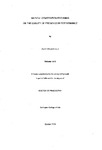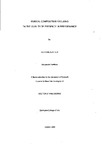MUSICAL COMPOSITION FOCUSING ON THE QUALITY OF PRESENCE IN PERFORMANCE
| dc.contributor.author | WIESENFELD, RUTH | |
| dc.contributor.other | Faculty of Arts, Humanities and Business | en_US |
| dc.date.accessioned | 2013-11-14T10:00:25Z | |
| dc.date.available | 2013-11-14T10:00:25Z | |
| dc.date.issued | 2008 | |
| dc.identifier | NOT AVAILABLE | en_US |
| dc.identifier.uri | http://hdl.handle.net/10026.1/2696 | |
| dc.description.abstract |
This practice-based research into the quality of presence in performance explores a compositional approach that originates from the question of what might lead a person to seek musical or sounding utterance. It aims at opening the awareness-space towards a listening not only to the musical-acoustic event, but to the performer as a whole. Consequently different forms of notation and processes of rehearsing that address the psycho-physical constitution of a performer are investigated; a strong focus lies on the sensorimotor aspect of playing an instrument. The portfolio comprises fourteen pieces (for soloists, chamber ensembles and orchestra) as well as four collaborative projects with performance artists. Most of the pieces have been performed live: documentation on CD and DVD is included. The written part of the thesis provides a commentary on the process of bringing these pieces into being. In particular, issues of notation and rehearsal are addressed here, which are of special concern as to the transmission of conceptions regarding presence, embodiment and kinaesthetic sensitivities. I explain how the body of compositions deals with various notions of listening: receptive listening and - in the chapter on the orchestral piece spun yam - listening as a sense of touch as well as listening in wonder. Illustrated by several performance projects I outline the concept of the audience as witness rather than as observer. Additionally, I describe how I use imagery to inscribe possible stimuli for musical or sounding utterance into my compositions. To demonstrate how this research contributes to new knowledge in the field of musical composition, I compare it with similar yet different positions exemplified by Mauricio Kagel's "instrumental theatre" as well as Helmut Lachenmann's "musique concrete instrumentale" and place it against more recent trends and developments. These evaluations will show that there is no other approach to the quality of presence within musical composition coinciding exactly with mine. | en_US |
| dc.language.iso | en | en_US |
| dc.publisher | University of Plymouth | en_US |
| dc.title | MUSICAL COMPOSITION FOCUSING ON THE QUALITY OF PRESENCE IN PERFORMANCE | en_US |
| dc.type | Thesis | |
| plymouth.version | Full version | en_US |
| dc.identifier.doi | http://dx.doi.org/10.24382/4750 |
Files in this item
This item appears in the following Collection(s)
-
01 Research Theses Main Collection
Research Theses Main



